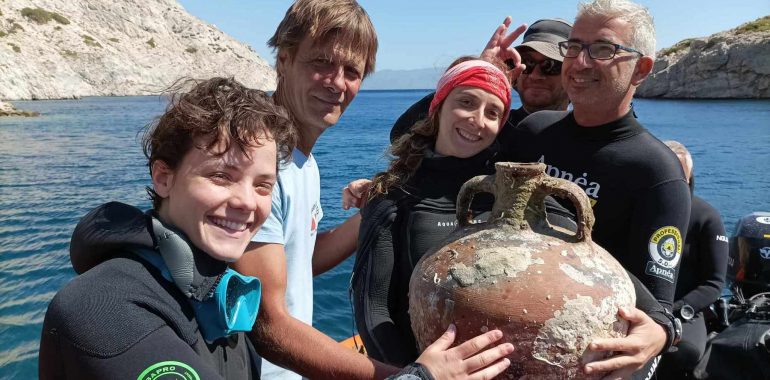Dozens of Amphorae Recovered From Ancient Byzantine Shipwreck in Greece

Dozens of Amphorae Recovered From Ancient Byzantine Shipwreck in Greece
Excavations of an ancient Byzantine shipwreck off the coast of Fournoi near Samos, Greece are bringing new finds onto the surface.
The wreck has been systematically excavated since 2021 and has been selected for intensive investigation due to the extremely interesting cargo it carries.
The amphorae found recently in the sand near the wreck, along with the wooden skeleton of the ship itself, were in remarkably good condition. Experts believe that the ship’s wooden framing survived throughout the centuries because it was crushed under the rest of the ship and oxygen couldn’t reach it, stalling the process of decay.
So far eight different amphora types have been recorded, originating from Crimea, Sinope of the Pontus region in the Black Sea, as well as from the Aegean islands and the Phocaean region of Asia Minor.

Pottery recovered at the ancient Byzantine shipwreck
The Ministry of Culture said that 170 group dives were carried out during the latest excavations. Archaeologists worked throughout the period to clear sand and debris from the wreck to provide access for experts to conduct studies of the site.
The scattering of the finds on the seabed seems to indicate a partial loss of cargo before the ship sank.
The recovered pottery was particularly enlightening, in terms of the more precise chronological inclusion of the wreck, which can now be safely dated between 480 and 520 AD, probably during the years of Emperor Anastasios I (491 – 518 AD), said a press release by the Greek Ministry of Culture.
Byzantine Emperor Anastasios I is known for his fiscal and monetary reforms, which strengthened the Empire’s coffers and enabled the expansionist policy of the emperors of the 6th century.

In parallel with the excavation of the wreck, findings from three more wrecks at the Fournoi archipelago were recovered, which are intended to be exhibited at the local archeological museum. Among these finds are a giant archaic anchor obelisk and amphorae from shipwrecks of the 6th to 8th centuries AD.
Countless ancient shipwrecks off Greece
There are many ancient shipwrecks across the Greek seas, and archaeologists have found countless historic treasures in these sunken archaeological sites.
In March 2024, the Ministry of Culture announced that scientists have discovered several shipwrecks and other important ancient finds in the underwater, near Greece’s island of Kasos.
These date back indicatively from prehistory (3000 BC), the Classical period (460 BC), the Hellenistic (100 BC to 100 AD), and the Roman years (200 BC – 300 AD) to the medieval and Ottoman periods.
Four stunning ancient shipwrecks filled with artifacts from antiquity and the Roman and Byzantine eras off central Greece can now be explored by amateur divers.
“We plan to highlight our marine cultural heritage,” Culture Minister Lina Mendoni said.
“We have responded to this great challenge by opening to the public a total of four underwater archaeological sites in the prefecture of Magnesia, which will allow Greece to join the world map of diving tourism.”